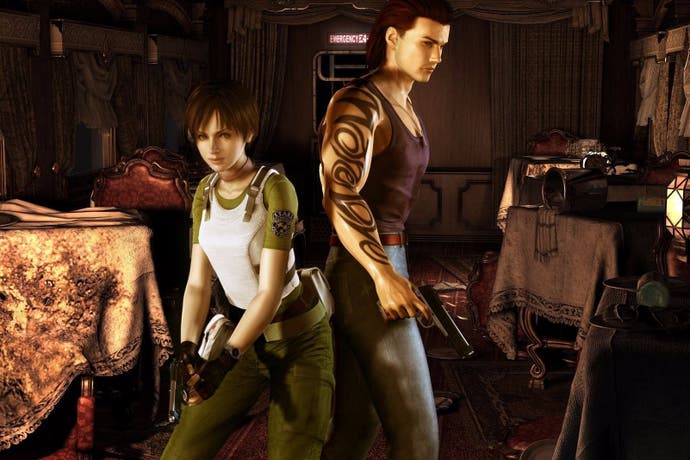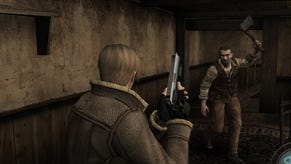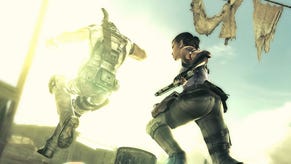Digital Foundry: Hands-on with the Resident Evil Zero HD Remaster
UPDATE: Xbox One/PlayStation 4 comparison video added.
UPDATE 15/1/16 4:00pm: We took a look at the Xbox One version of the Resident Evil Zero HD remaster and initial impressions suggest we're looking at platform parity here. Here's a short comparison video. We'll be bringing PC into the mix next week when the game launches and offering our final verdict then.
Original story: After the excellent Resident Evil remaster on PS4, Xbox One and PC last year, Capcom's restoration efforts are now directed to Resident Evil Zero. Due next week, this prequel has so far only graced Nintendo's GameCube and Wii - a gem of an exclusive that boasted some of the best-looking pre-rendered backdrops at the time. Now it's coming to Xbox One, PC and PS4 with a full 1080p widescreen presentation, upgrades to lighting and model detail, plus a new control scheme.
We've taken an initial look at the PS4 version and the new edition is looking good. The Zero remaster is largely based on the 4:3 aspect ratio backgrounds used in the 2002 GameCube release. To hit the spec of a 16:9 presentation here, Capcom resorts to panning the camera up and down, dependent on character movement. It's a smart approach and one that's adjusted on a scene-by-scene basis, giving the benefits of a full widescreen experience while still showing the entirety of the original background art. Ultimately this is the best way around the problem, and the scrolling effect doesn't distract. For purists though, a 4:3 aspect ratio mode is still included.
Resident Evil Zero's video sequences are dealt with in a rather more straightforward manner. The original cut-scenes were rendered at 16:9 at the time of production, in a bordered format as they were output by the Wii and GameCube. Fortunately, this format works out perfectly for the remaster, and each cut-scene now simply fills a widescreen space on PS4 - with nothing cropped, or lost in the transition. In truth, these video sequences aren't as crisp as the in-game backdrops, but they still link in seamlessly with the in-game action. It's also a telling sign of how diligently Capcom's archived this source material, after the project had drawn to a close.
Looking at the GameCube's original 2D assets, the level of detail invested in each area is still remarkable. The real selling point was its animated backdrops, one highlight being a slow walk across a blustery train carriage, rain hammering down overhead, and lamplights flashing past. We're pleased that Capcom sets out to preserve this visual direction exactly as it was intended, only retouching the colour balance where needed and subtly embellishing a few foreground details to suit the 1080p standard.
Resident Evil Zero's visuals are upgraded in a broader sense too. An improved lighting model is incorporated into its engine, with bloom added to each light - such as the lamps and chandeliers strewn across each carriage. As with the GameCube release, these light points aren't just for show. Shadows are dynamic, affecting any fully polygonal elements in a scene, such as characters and zombies. In some scenes this results in PS4 shadows falling at a slightly different angle, while also operating at a higher resolution.
Added to this, the new approach to lighting means character skin and clothing react differently during cut-scenes - producing a brighter, more blended look. This is also a product of notable changes to their modelling, particularly in close-ups, that now match the rigs used in the FMV renders more closely. Our video above demonstrates the extent of the change in facial detail, but for our money, it's a well-judged upgrade that crucially keeps its faith in the original designs.
So far, we've focused on the opening train segment of Resident Evil Zero owing to pre-release content restrictions, but everything we've played so far points to an accomplished remaster of this classic. Effects are upgraded (notably to fire transparencies), and we're seeing a bevy of smart visual upgrades wherever they're possible. In terms of functionality, we also get a similar option screen to last year's Resident Evil remaster; two aspect ratios are selectable from the start, and there's an 'alternative' controller scheme, where characters movement is directly controlled by tilts to the analogue stick.
As for the frame-rate - perhaps something of a moot point given this game's slower pace - the PS4 version runs at 30fps, in line with the original. Though not crucial for a survival horror game in this fashion, we're intrigued to see if the PC version offers a 60fps mode as a bonus, as with last year's remaster. Another question mark is also raised over whether any fully 3D environments are introduced in the HD edition - a cool component of last year's remaster, and something we'll investigate in due course. We'll be back with more Resident Evil Zero next week, including a look at the game on all three platforms.


















.png?width=291&height=164&fit=crop&quality=80&format=jpg&auto=webp)
